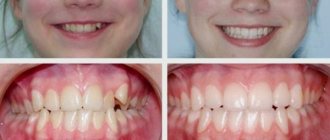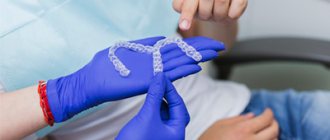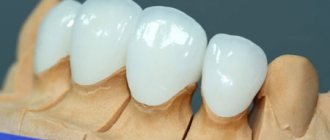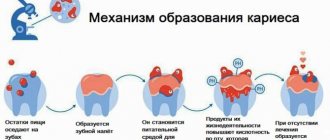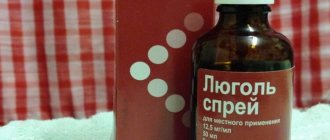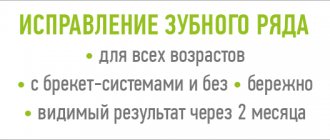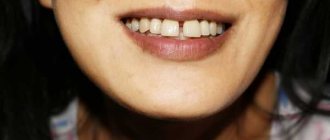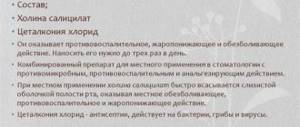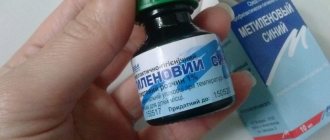Most often, dentists use braces to correct bite defects, but sometimes pathologies require correction using more complex structures. One of such devices is considered to be FNTA - a device made on the principle of operation of the Herbst apparatus. The functionality of the product is aimed at blocking the backward displacement of the lower jaw.
Made from ultra-durable medical titanium alloy. The material is hypoallergenic and elastic, which allows dentists to talk about its safety and functionality. Consists of crowns, hinge beams and connecting rings.
Plate apparatus for the upper jaw with a Coffin spring
If it is necessary to expand the upper jaw in the distal areas, the spring is placed with the open part back (Fig. 2), and if it is necessary to expand the frontal area, then forward (Fig. 1). If it is necessary to uniformly expand the upper jaw in the lateral areas, two Coffin springs are used - one located with the open part forward, the second - backward (Fig. 3-4). If it is necessary to lengthen and expand the upper jaw, three Coffin springs are used: two in the frontal area and a third (or two) in the middle of the palatal suture (Fig. 5).
Advantages and disadvantages
The advantages of the button include:
- the effectiveness of protection against tooth displacement in the event of the formation of clefts between units (when a permanent tooth does not erupt for a long time);
- aesthetics when wearing;
- minimum adaptation period.
Negative qualities of the design include the need to exclude from the diet foods that can damage the device (food that is too hard, viscous).
From diagnosis to installation
Only a dentist can tell whether the structure needs to be installed. In addition, based on the diagnosis, the doctor determines the method of fixing the device.
Then everything happens in this order:
- During the first visit, the dentist determines the size of the retainer rings based on the size of the units requiring correction.
- To determine the exact distance between the rings and the button, an impression is made.
- The rings are placed in the impression, the mold is filled with gypsum mortar. This creates a model of the structure.
- After this, the wire is adjusted to the curve of the palate and the ends of the wire are soldered to the rings.
The dentist installs the finished device into the patient’s oral cavity. The entire process from diagnosis to installation of the structure takes about 5-7 days.
Installation of the structure
Trying on a plastic plate is the first and main stage, which cannot be bypassed, since it is during this fitting that the dentist determines the position of the Nance button in the oral cavity. To properly fix the appliance, the plate should be positioned at the level of the edge of the second premolars. The second edge of the plate should be in the area of the middle of the fangs.
The rings are attached to the fangs using dental glue (cement). After adjusting the frame to the outside of the dentition, a hook and a spring are placed.
The bent loop at the end of the row is put on the fang, and the end of the wire remains uncut.
The metal elements of the structure are tightened, distributing the load evenly across the units.
Treatment and care
The process of wearing the device takes on average about 1-1.5 months. If during this period the alignment of the dentition has not occurred, the doctor decides to extend the treatment period. In this case, the spring is removed to increase the pressure on the teeth.
This design is considered stationary and cannot be removed throughout the correction period. Quick adaptation is due to the possibility of making the button from a soft material.
Naturally, the plate causes discomfort in the first days, since the button takes up the space where the tongue is usually placed. During the adaptation period, speech dysfunction sometimes occurs, but adaptation passes quite quickly.
Duration and effectiveness of treatment, prices
| Click to sign up for a FREE consultation |
Since using the Nance button, a displacement of the unit in a given direction within 2-3 mm is achieved, the duration of treatment depends on the severity of the pathology. Usually the correction takes a period of 3-5 months, but if there are indications, dentists extend the treatment up to 1 year.
The device is used exclusively to eliminate dystopia of the upper jaw.
The average price of treatment using this device ranges from 12 to 15 thousand rubles. The dentist will announce the specific price after determining the materials for making the Nance button and determining the severity of the disease.
Plate device for the upper jaw with a screw
If it is necessary to uniformly expand the upper dental arch, a screw with two guides is welded along the palatal suture and the corresponding cut is made (Fig. on the left). If a screw with two guides is positioned perpendicular to the palatal suture, then in this case the frontal portion of the upper dental arch will be lengthened (Fig. on the right). To lengthen the frontal section of the upper dental arch, you can use two skeletonized screws (with one guide), which are often located in the canine area, or a trapezoidal screw. The cut in such cases can be sectoral or straight (perpendicular to the palatal suture).
If it is necessary to change the transverse dimensions of the right or left side of the dental arch of the upper jaw (with a unilateral cross laterogenic bite), a screw with two guides is placed obliquely and a cut is made to the screw along the palatal suture, and the next cut is sectoral; in such cases, it is possible to use a trapezoidal screw.
To lengthen the upper jaw in the distal sections, a single-guide screw is placed in the area of those teeth that will be displaced distally, most often in the area of the canines or premolars. For symmetrical extension, two screws are used (Fig. on the left).
Types of orthodontic appliances
There are a huge variety of orthodontic appliances, which differ in their mechanism of action, as well as in the method of fixation.
The Shifa clinic uses the most modern equipment available today. Orthodontic appliances can be removable or non-removable.
Orthodontic plates are removable structures, the base of which is made of soft hypoallergenic plastic. The therapeutic effect is realized due to the gradual displacement of the dentition. The system additionally includes screws, a variety of springs, arches and hooks. The plastic part of the structure fits closely to the patient’s palate, exactly repeating its contours, and with the help of the metal elements of the plate, it is attached to the teeth and subsequently aligned. The main role is played by the screw, which is located in various parts of the plastic structure. It provides changes in the size of the plate, which allows you to influence the position of the jaws and teeth in the mouth.
Orthodontists at the Shifa clinic point out that with the help of the described device it is possible to achieve optimal results in children and adolescents. Dental plates work best during jaw growth and the replacement of primary teeth with permanent ones. However, they can also be used as an adjunctive treatment in adult patients.
Indications for use of plates:
- the need to change the shape of the jaws;
- influence on the rate of jaw development;
- fixation of the dentition in a certain position;
- change in the position of fangs, incisors or other teeth;
- change in the shape or size of the sky.
Plate device for the lower jaw with a screw
In the lower jaw, a screw with two guides is placed on the oral side of the alveolar process above the frenulum of the tongue. The cut is carried out vertically (Fig. 3). If it is necessary to lengthen the lower dental arch, two screws are inserted into the design of the apparatus, which are placed in the area of the canines (Fig. 2) or the first premolars (first temporary molars). Saw the apparatus vertically on both sides. In such cases, elongation occurs in the frontal and distal sections.
If it is necessary to expand and lengthen the lower dental arch, three screws are used, one of which is located above the frenulum of the tongue, and the second and third symmetrically in the area of the canines or first premolars. The apparatus is sawed vertically at the location of the screws (Fig. 1).
Advantages and disadvantages
The advantages of using the device include:
- 24-hour correction;
- the design is non-removable and does not require additional maintenance or removal;
- there are no dietary restrictions, the patient continues to adhere to the usual menu;
- the adaptation period is short, there is no discomfort or pain;
- immediately after installation, visual changes in the facial profile are visible;
- the first lasting effect is noticeable within six months after installation;
- treatment results are predicted;
- the design is reliable, breakdowns are rare, but can be quickly repaired;
- oral hygiene is simple, which sets the device apart from classic braces;
- can be installed simultaneously with other types of structures for correction;
- resistance to external influencing factors;
- can be used for hypomineralization of enamel;
- no complications, airway difficulties, diction problems;
- can be used for children under 16 years of age as an effective alternative to surgical correction;
- affordable price.
Flaws:
- the product is bulky, the aesthetics are poor, since the structural elements are noticeable from the outside;
- some Patients are embarrassed by their appearance, since the metal is very noticeable when talking or eating;
- risks of injury to soft tissues and oral mucosa when worn, which causes slight swelling and pain;
- Despite the ease of care, some hygiene problems may arise, for example, it is difficult to remove all food debris without an irrigator.
Some Patients develop a negative reaction to the presence of a foreign object in the oral cavity. In this case, the dentist dismantles the device and chooses other treatment methods.
Price
The cost of the device will depend on the type of design. The price tag for all treatment always includes preparatory procedures for correction and adjustment of traction.
Pricing factors also include:
- prestige of the clinic;
- pricing policy of the dental institution and the region of its location;
- doctor's qualifications;
- complexity of the clinical case.
Let's look at the average cost of the above devices using the table as an example.
| Model | Price in rubles |
| Plate with Coffin spring (upper jaw) | From 12 000 |
| Plate with screw (upper jaw) | From 8 000 |
| Plate with fan-shaped screw (upper jaw) | From 10 000 |
| Appliance with screw (lower jaw) | From 9 000 |
| Apparatus with Koller springs (lower jaw) | From 11 000 |
Price
The use of the Nord apparatus allows you to cope with different types of narrowing of the jaw. It provides a quick onset of effect, and what is important, the device does not interfere with a person’s ability to lead a full life.
It should also be noted that the device does not cause difficulties during daily hygienic care of the oral cavity.
When installing a Nord device, the pricing will be influenced by the following factors:
- Additional diagnostic procedures. In some cases, an X-ray or CT scan may be required.
- Individual characteristics. When manufacturing the device, the anatomical features of the oral cavity and the degree of neglect of the pathological process are taken into account.
- Status and prestige of the dental clinic.
- Region of Russia. In large cities, the price of the product will be slightly higher.
- Qualifications and skills of a specialist.
The cost of manufacturing the device is within 10,000 rubles. Taking into account additional procedures and diagnostic measures, the total cost ranges from 20,000 to 30,000 rubles.
The cost of manufacturing orthodontic plates in Moscow at the Shifa clinic
Teeth straightening with the help of removable and fixed devices is distinguished by its accessibility in comparison with braces. The average price of appropriate treatment in Moscow ranges from 10 to 30 thousand rubles. It all depends on the characteristics of a particular clinical case.
Shifa Clinic is a modern medical center offering patients the highest quality services. The selection of the device model and calculation of the cost of the entire course of treatment is carried out individually for each patient. More detailed information can be obtained by reading our price list on the clinic’s website, or by calling our contact numbers.
We cooperate only with leading manufacturers of orthodontic products, which guarantees the safety and quality of the devices used. Doctors at the Shifa clinic will make your smile truly healthy and beautiful. Contact professionals to become the owner of a Hollywood smile!
Course duration
Mechanical orthodontic devices, such as the Ainsworth device, work slowly. Before starting the course, the doctor can only give an approximate estimate of recovery time. It is impossible to force the process, since excessive pressure can disrupt the vascular channels that supply the teeth with nutrients, which will lead to dangerous complications.
It will take a year or two for the design to help achieve results. The timing depends on the clinical picture at the start of the course, age and individual characteristics of the person.
Rules for wearing and duration of treatment
The duration of treatment ranges from six months to ten months. However, non-compliance with wearing rules or other factors influencing the effect can slow down the process of getting rid of pathologies.
The combination of this design with others (for example, braces) usually helps to speed up the elimination of defects.
However, experts recommend carefully monitoring compliance with the instructions for wearing the device:
- Mechanical impact on the jaw system must be completely avoided. This may damage the elements of the device itself or affect the fixation of the abutment crowns.
- C-shaped fastenings also require careful attention . Changes in their external data is a significant reason for urgent replacement. Damage to these elements can lead to the inability to chew food and the elementary opening of the mouth.
Adaptation
In the first days after receiving an Ainsworth orthodontic product, most people experience discomfort and discomfort. For some, the presence of a foreign body in the mouth can cause increased salivation, difficulty speaking and eating. Pain of moderate intensity is normal during this period. To alleviate the condition, doctors advise taking approved doses of painkillers.
Severe pain is a signal that you need to visit the dentist ahead of schedule. The doctor will evaluate the factors leading to severe pain and advise on how to ease the discomfort.
How the device works
The rapid expansion of the jaws, when using the Nord apparatus, is facilitated by force. By applying pressure, it acts on the median seam. The device is activated by turning the screw. It is performed 1 or 2 times during the day (based on the degree of neglect of the pathology by ½ or ¾ of a turn).
Active expansion is observed within 2-4 weeks. After this, the device is no longer activated, but it can only be removed after a period of 3 to 6 months.
During this time, restructuring (fusion) of the suture tissue occurs. This period of time also prevents the development of a possible relapse.
Reviews
The hardware method of orthodontic treatment with mechanical constructions occupies a leading position among other methods for correcting dentoalveolar defects existing in dental practice.
The essence of the method is the targeted redistribution of functional and mechanical pressure on the elements of the dentition and other structures of the dental system.
Have you ever worn mechanical orthodontic appliances? If yes, then we ask you to leave your feedback in the comments below the article about the advantages and disadvantages of such structures.
If you find an error, please select a piece of text and press Ctrl+Enter.
Tags devices: bite correction
Did you like the article? stay tuned
No comments yet
Activation
It is strictly forbidden to activate the Ainsward apparatus independently based on your own sensations. To activate, the patient must visit a dentist every 8-10 days to monitor the process. If the next consultation is postponed for a longer period for some reason, this must be reported to the doctor in advance so that he can increase the pressure during the previous visit. However, every effort should be made to adhere to the visiting schedule, as absences will increase the recovery rate.
In rare cases, the orthodontist will show you how to properly activate the archwire. If he trusts the patient or his parents enough, he may allow them to perform the activation at home, but this does not eliminate the need to come for an examination once every 8-10 days.
Operating principle
The operation of the Nord system is based on the creation of an expanding force by the Hyrax screw and its transmission to the palatal surface of the chewing teeth through rings and acrylic plates. Under its action, the palatine bone expands along the line of the median suture.
It ruptures if it has already fused, or expansion occurs without rupture if obliteration of the suture has not yet occurred. The device is activated by turning a screw with a special key by the patient himself or another person.
There are fast and slow expansion technologies. With fast, the screw is tightened once or twice a day by ½ or ¾ of a turn, which is 0.2-0.5 mm. With slow expansion, the screw is activated once every 3 days. The most commonly used is rapid expansion.
The active phase of treatment is followed by a retention period, ensuring the absence of relapse and the fusion of the palate bones in the new position.
The essence of the use of the Alf system in orthodontics and the effectiveness of the device.
In this publication we will talk about the purpose and types of bionators.
Here we will consider the technique of using the Persin apparatus to correct mesial occlusion.
Manufacturing process
The manufacturing process of the Nord device occurs in stages in compliance with the following algorithm of actions:
- Initially, an examination is carried out and the degree of the pathological process that caused the anomaly is revealed;
- if necessary, additional diagnostic procedures are prescribed (x-ray or computed tomography);
- impressions are taken from the jaws in the dental office;
- Based on the completed models, support parts with wire loops are made in the laboratory, which will subsequently be filled with acrylic;
- upon a second visit, support elements are installed on the teeth;
- casts are made with installed supports;
- based on the resulting model, expanding parts are manufactured (including the Hyrax screw);
- in the laboratory, all elements are assembled into one whole with an expanding part (with acrylic plates poured);
- After fitting and modification, the device is installed on the jaw.
